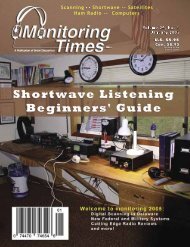OPERATION MANUAL AM/FM/SHORTWAVE RADIO - TextFiles.com
OPERATION MANUAL AM/FM/SHORTWAVE RADIO - TextFiles.com
OPERATION MANUAL AM/FM/SHORTWAVE RADIO - TextFiles.com
You also want an ePaper? Increase the reach of your titles
YUMPU automatically turns print PDFs into web optimized ePapers that Google loves.
E10 <strong>OPERATION</strong> <strong>MANUAL</strong><br />
11 LISTENING TO <strong>SHORTWAVE</strong> STATIONS<br />
LISTENING TO <strong>SHORTWAVE</strong> STATIONS continued<br />
Are you new to shortwave listening? If so, you’ll<br />
want to read this section and the next section<br />
called UNDERSTANDING <strong>SHORTWAVE</strong> BANDS.<br />
WHAT ARE <strong>SHORTWAVE</strong> STA-<br />
TIONS?<br />
These are radio broadcast stations around the<br />
world broadcasting on frequencies that can be<br />
heard over vast distances, often many thousands of<br />
miles. In the United States, there are also about 30<br />
domestic shortwave broadcasters with religious,<br />
politically and ideologically oriented broadcasts.<br />
WHY LISTEN TO <strong>SHORTWAVE</strong><br />
STATIONS?<br />
There are many reasons why you may enjoy shortwave<br />
stations. Here are just some, as reported to<br />
us by our customers.<br />
• Listening to news and information from other<br />
world sources often exposes you to different and<br />
unique perspectives on national and world events.<br />
• Exposure to other languages and cultures,<br />
including their music and perspectives. Hearing a<br />
country’s native or ‘folk’ music can be very enjoyable,<br />
even if you don’t understand the language.<br />
GENERAL <strong>SHORTWAVE</strong> ‘RULES-<br />
OF-THUMB’<br />
• Night shortwave reception is usually better than<br />
daytime shortwave. This can change from time-totime,<br />
so it’s worth checking the bands during the<br />
day too.<br />
• During daytime the most active shortwave bands<br />
are 13, 15, 16, 19, and 22 meters. 16 and 19 usually<br />
being the best. At night, the most active bands<br />
are 25, 31, 41 and 49 meters, with 31 and 49 usually<br />
best.<br />
• Around sunset and sunrise, both the day and<br />
night bands may be good, sometimes exceptionally<br />
good. Listening at these times can often be quite<br />
rewarding.<br />
• The construction materials of some buildings<br />
severely block shortwave signals. To counteract this,<br />
hold the radio in your hands and get very close to<br />
a window.<br />
SELECTING A <strong>SHORTWAVE</strong><br />
METER BAND WITH THE E10<br />
All 14 of the international broadcast bands can be<br />
accessed with the E10. The bands are numbered<br />
120, 90, 75, 60, 49, 31, 25, 22, 19, 16, 15, 13 and<br />
11 meters and are <strong>com</strong>monly called ‘Meter Bands’.<br />
The E10 offers two ways to access a shortwave<br />
band. Each method places the tuner at the beginning<br />
of the band’s frequency range.<br />
1. Each successive quick, short press of the button<br />
labeled SW METER BAND (16) places the radio at<br />
the beginning of a band. While pressing the button,<br />
the band number shows in the upper right corner<br />
of the display (50) and disappears a few seconds<br />
after it is released, causing the clock to reappear<br />
in the corner. Start tuning only after the clock<br />
reappears. If you don’t wait, then method 2, below<br />
will automatically be used.<br />
2. Perform one quick, short press of the button<br />
labeled SW METER BAND, immediately followed by<br />
quick, short presses of either the Up/Hour or<br />
Down/Min. tuning buttons. The band number<br />
appears in the upper right corner of the display.<br />
Once the band of choice is selected, start tuning<br />
after the clock reappears in the upper right corner.<br />
AUTO-SCAN TUNING WHILE IN<br />
<strong>SHORTWAVE</strong><br />
In shortwave, auto-scan tuning scans in the shortwave<br />
frequency ranges noted in the Band Chart<br />
below. To tune shortwave frequencies that are inbetween<br />
these ranges, or outside of these ranges,<br />
use one of the other tuning methods, e.g. Regular<br />
Tuning (manual tuning) or Direct Frequency Entry<br />
as discussed titled TUNING IN STATIONS.<br />
• Learning a language by hearing native speakers.<br />
• Keeping in touch with another part of the world,<br />
perhaps your original homeland or that of your<br />
family’s heritage.<br />
• Religious, politically and ideologically oriented<br />
broadcasts.<br />
20<br />
21

















